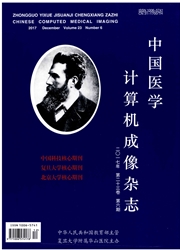

 中文摘要:
中文摘要:
目的:运用DTI初步探讨椎间盘退变。方法:对420个椎间盘行DTI横断面扫描,测量其MD、FA值并获得其纤维环成像图。根据Pm分级,对不同级别椎间盘进行定量分析比较。结果:MD、FA值与Pm分级密切相关,Pm级别越高,MD值越低,FA值越高,且具有统计学意义。运用FiberTracking技术每个椎间盘均可得到FT图,且不同Pm级别其纤维环FT图不同,MD值、FA值差异具有统计学意义。结论:DTI可无创性评估活体椎间盘退变,MD值及FA值是评价椎间盘退变程度的重要参数。
 英文摘要:
英文摘要:
Purpose: To detect the earlier changes of degeneration discs by using magnetic resonance diffusion tensor imaging. Methods: Magnetic resonance diffusion tensor imaging was performed for 420 intervertebral discs. The MD, FA values were measured and the annulus imaging was obtained. The MD and FA values between different Pm grades were analyzed and compared. Results: 1. FA and MD values were correlated with Pfirrmann grades of degenerated intervertebral discs: The higher the Pm grade was, the lower the MD value and the higher FA value was. There were significant differences of the MD and FA values between different Pm grades by the Kruskal-Wallis rank sum test, P 〈0.05. 2. Based on FT maps to evaluate the annulus fibrous of degenerated intervertebral disc, they were divided into 2 types according to the symmetry and integrity of the motion curve of the annulus fibrous hydrones: intact type and scrambled type. The median and the interquartile range of MD and FA values in different types based on FT maps were tested by Kruskal-Wallis test, which were with statistical significance. Conclusions: DTI is a non-invasive assessment of intervertebral disc degeneration in vivo, MD and FA values are important parameters to evaluate the grade of intervertebral disc degeneration.
 同期刊论文项目
同期刊论文项目
 同项目期刊论文
同项目期刊论文
 期刊信息
期刊信息
